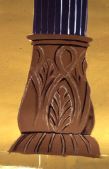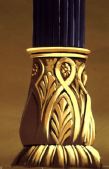
|
Detail of Original Column Base |
Copy of Column Base |
|---|---|
|
|
|
|
Masonic Temple - Kansas City, KS |
Instructional Panel Development |

|
Detail of Original Column Base |
Copy of Column Base |
|---|---|
|
|
|
|
Masonic Temple - Kansas City, KS |
Instructional Panel Development |
The art of scenic backdrop painting is a rapidly dying art in the theatre. The techniques of painting this type of scenery at one time flourished with many studios offering a wide array of stock drops for theatres all over America. With the conversion of "Opera Houses" to movie theatres, most of these drops painted from 1900-1950 were destroyed or lost. There remain few examples of this magnificent art form readily available for study by theatre students. Masonic Temples were customers of these scenic studios as well and still own and use regularly this type of scenic drop. The secrecy of the Masonic Order has , until now, prevented the documentation and study of this scenery.
Now, due to an extraordinary partnership with the Masonic leadership, theatre researchers have been allowed access to the primary resource materials - actual scenic drops painted during the "golden age" of theatrical scene painting. The opportunity to study these drops and photograph them in detail has been beneficial to both organizations. The Masons have received valuable information on the source and traditions associated with the irreplaceable scenery. We have assisted them with information on repair and preservation issues as well. Theatre researchers now have images to use which document this most important part of our history and we are now able to develop methods of teaching this almost lost art of scenic painting.
Having now visited many of the sites with the scenery and assembled a large number of slide images of the painting techniques used in completing these classic drops, I am ready to embark on the part of the project involving the development of instructional modules to teach the step-by-step process for teaching the painting of these techniques.
|
Furman Advantage Students |
|---|
|
|
|
Working on Painting Instructional Modules |
Students at Furman continue to use the close-up photographs in classes as models for learning these scene painting techniques. Students painting the scenery for the production of Red Magic used the slides as models for the detail painting on that set. For the summer of 1994, two Furman Advantage students (Alan Bryson and Kirkland Dickey) assisted in the development of the instructional modules to teach the techniques. A paint frame was constructed in the scenery construction shop of The Playhouse. Four by four foot cloth panels were used to develop details of the painting. Photographs were made of the separate steps required to create the various textures and effects. The process was further documented in text form and the text and the photographs will form the core of the proposed book on scene painting which is to emerge at the end of this process.
Here is an example of one of the painting technique Instructional Modules. It shows the original image from the research photographs and then the successive steps necessary to replicate the technique. The original image is a detail from scenery photographed in the Masonic Temple in Kansas City, KS and painted by Don Carlos DuBois of the Great Western Scenic Company.. The Instructional Module was painted by Alan Bryson.


The Five Steps to complete the column detail.
Scene Painting Workshops at the USITT
Send Rhett E-Mail: rhett.bryson@furman.edu